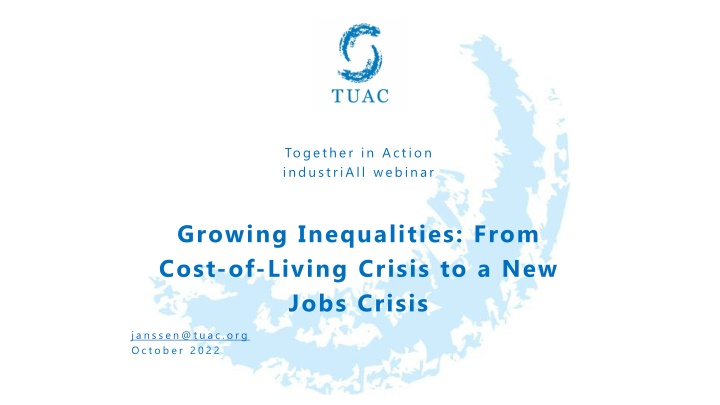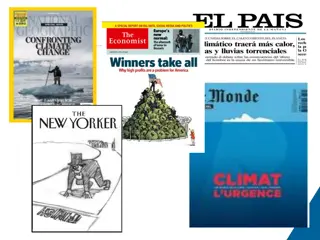Addressing Global Inequality: Challenges and Solutions
Explore the impact of income and wealth disparities on societies worldwide in a webinar highlighting the urgent need for stronger wage formation and equitable economic policies. Delve into the root causes of rising inequalities, their damaging effects on poverty, economic growth, and democracy, and the importance of pre-distribution strategies in combating these challenges.
Uploaded on Sep 18, 2024 | 1 Views
Download Presentation

Please find below an Image/Link to download the presentation.
The content on the website is provided AS IS for your information and personal use only. It may not be sold, licensed, or shared on other websites without obtaining consent from the author.If you encounter any issues during the download, it is possible that the publisher has removed the file from their server.
You are allowed to download the files provided on this website for personal or commercial use, subject to the condition that they are used lawfully. All files are the property of their respective owners.
The content on the website is provided AS IS for your information and personal use only. It may not be sold, licensed, or shared on other websites without obtaining consent from the author.
E N D
Presentation Transcript
Together in Action industriAll webinar Growing Inequalities: From Cost-of-Living Crisis to a New Jobs Crisis j a n s s e n @ t u a c . o r g O c t o b e r 2 0 2 2
Presentation Presentation The state of global inequality Cost-of-living crisis requires stronger wage formation Return of the old economic policy narrative risks fuelling a crisis and stooking higher inequalities Conclusion
Part I Part I The State of Global Inequality
Income and wealth inequalities are staggering Income and wealth inequalities are staggering
Inequality lowest in Europe, highest in MENA Inequality lowest in Europe, highest in MENA
Top 10% earning 10 to 32 times more than the Top 10% earning 10 to 32 times more than the bottom 50% bottom 50%
Redistribution helps but pre-distribution keeps driving inequality
Decades of increasing inequalities (1) Decades of increasing inequalities (1)
Decades of increasing inequalities (2) Decades of increasing inequalities (2)
Decades of increasing inequalities (3) Decades of increasing inequalities (3)
The cost of high and rising inequalities The cost of high and rising inequalities Entrench and recreate poverty and low living standards over the generations Holding back growth and economic recovery Root of financial market instability Destroy capital of trust which is key to finding compromises to shocks and crisis Danger to democracy
Why? Markets unleashed (1) Why? Markets unleashed (1)
Why? Markets unleashed (2) Why? Markets unleashed (2)
Part II Part II A Cost-of- Living Crisis
Headline inflation skyrocketing Headline inflation skyrocketing
Reasons behind soaring energy prices Reasons behind soaring energy prices Strong recovery in the aftermath of COVID-19 with oil supply lagging behind Gas spot delivery squeezed by Russia Ukraine war Food: weather events (climate change) plus second-round effect of energy prices
Poorest under pressure (Only?) Poorest under pressure (Only?)
Direct hit on purchasing power of wages Direct hit on purchasing power of wages
High inflation eroding the real value of High inflation eroding the real value of statutory minimum wages statutory minimum wages
A double blow for low pay workers A double blow for low pay workers
Policy messages from recent OECD Policy messages from recent OECD Employment Outlook Employment Outlook Bold action is vital to support living standards of the most vulnerable The sharp rise in energy and food prices is a cost that risks falling disproportionally on the most vulnerable, low-income households. Comprehensive negotiations between governments, workers and firms will be key to fairly share this cost: none of them can absorb it alone. Adjust the minimum wage to maintain effective purchasing power for low-paid workers is among the policy options that could be considered by governments . Protecting living standards also requires rebalancing bargaining power between employers and workers, so that workers can effectively bargain for their wage on a level playing field . Rebalancing bargaining power, however, also means giving a new impetus to collective bargaining and, therefore, accompanying the efforts of unions and employer organisations to expand their membership and enlarge the coverage of collective agreements .
Further background: New Analysis on Further background: New Analysis on Employer Power in the labour market Employer Power in the labour market Labour markets are not competitive but monopsonic Similar to monopoly in product markets: A monopolist limits the production of goods and services so he can sell at high prices and make extra profits Monopsony employers limit hiring of workers so they can pay lower wages and have higher profits. Bad for wages, bad for jobs. OECD - messages Monopsony in labour markets is pervasive Countervailing powers : More mobile workers but also collective bargaining and minimum wages
Part III Part III From Cost of Living crisis to a new Economic crisis
Major shift in narrative of central banks: Get Major shift in narrative of central banks: Get high inflation down, whatever the cost high inflation down, whatever the cost
Unprecedented tightening : Risk of a global Unprecedented tightening : Risk of a global recession (1) recession (1)
Unprecedented tightening : Risk of a global Unprecedented tightening : Risk of a global recession (2) recession (2)
Unprecedented tightening : Risk of a global Unprecedented tightening : Risk of a global recession (3) recession (3)
Why are central banks hitting the brakes? (1) Why are central banks hitting the brakes? (1) Blaming COVID related fiscal policy for boosting aggregate demand way above aggregate supply potential of their domestic economies Does not make sense : High inflation essentially originates from the outside/ global energy markets, implying that: Tightening monetary policy does not do anything to remedy this Aggregate demand already reduced because purchasing power is redistributed from the domestic economy to the energy producing countries Such price hikes tend to be volatile and may stop (return to much lower inflation) or may even reverse (too low inflation). Monetary policy reacting to such high headline inflation translates global price volatility into domestic economy volatility: Unstable domestic environment not good for growth.
Why are central banks hitting the brakes ? (2) Why are central banks hitting the brakes ? (2) High inflation risks becoming self-sustained: Shift in mass psychology towards high inflationary expectations with wage-price spirals as a result To avoid psychology of high inflation from becoming entrenched, hit the brakes now. If not, inflation expectations will edge up requiring more action to squeeze demand/an even deeper recession later.
A look at inflationary expectations A look at inflationary expectations
Not the seventies either (1) Not the seventies either (1)
Not the seventies either (2) Not the seventies either (2)
A risk being overlooked: Consequences of A risk being overlooked: Consequences of labour market hysteresis labour market hysteresis Labour market hysteresis: Cyclical unemployment becoming structural because Unemployed workers loose skills Employers start discriminating against long term unemployed Capital gets destroyed. When demand recovers, the capital to employ workers is missing . Implication: Monetary policy pushing for a recession in the hope of avoiding the need to take more drastic measures in the future may make things worse by weakening future aggregate supply
Concluding Concluding Big challenges ahead Upgrade collective bargaining and wage formation systems Shift towards an employment friendly macroeconomic policy narrative Opportunity for a new new deal ? Looking to past experience Looking to the future
New Deal, Wagner and War spending in the US New Deal, Wagner and War spending in the US
European Minimum Wage Directive European Minimum Wage Directive Collective bargaining coverage 120 100 80 60 40 20 0























